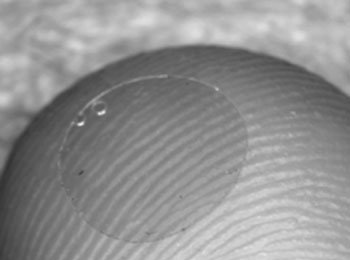Innovative Nanowafer Enhances Ocular Therapeutic Efficacy
By HospiMedica International staff writers
Posted on 19 Feb 2015
A new study describes a drug-releasing wafer that works better than a medicine dropper for eye injuries, and could help patients recover faster. Posted on 19 Feb 2015
Developed by researchers at Baylor College of Medicine (BCM; Houston, TX, USA), the nanowafer is a small, transparent circular disc made of a non-toxic polymer that is similar to a contact lens. The disc contains arrays of nanoreservoirs loaded with axitinib embedded throughout. The slowly dissolving nanowafer retards drug release over time, thus increasing drug residence time on the ocular surface and promoting absorption into ocular tissue. At the end of the stipulated period of drug release, the nanowafer dissolves and fades away.

Image: The axitinib nanowafer (Photo courtesy of Baylor College of Medicine).
The efficacy of the nanowafer was demonstrated by studying corneal neovascularization (CNV) in a murine ocular burn model. Laser scanning confocal imaging and reverse transcription polymerase chain reaction (RT-PCR) revealed that once a day application of the axitinib nanowafer was twice as effective as that of twice a day delivery of axitinib by topical eye drop therapy. The nanowafer did not affect wound healing and epithelial recovery of the ocular burn induced corneas. The study was published on January 27, 2015, in ACS Nano.
“We found that the nanowafer was much more efficient compared to eye drop treatment. For example, once a day nanowafer treatment has almost twice the efficacy compared to delivering eye drops two times a day,” said senior author Ghanashyam Acharya, MD, an assistant professor of ophthalmology at BCM. “It slowly dissolves and maintains a high concentration of the drug in the tear film and loads up the tissue to provide better efficacy.”
“Eye drops are very inefficient because they are diluted out by the tears and then rapidly washed away from the eye, so there’s very little time for the medication in the drop to be picked up or absorbed by the tissue, and as a consequence the concentration of it doesn’t achieve a high level,” added coauthor Prof. Stephen Pflugfelder, MD.
Related Links:
Baylor College of Medicine














